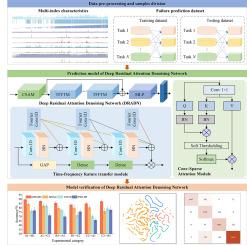Failure prediction of gas-bearing coal–rock combination with different high ratios based on acoustic emission response characteristics
IF 2.1
3区 地球科学
Q2 GEOSCIENCES, MULTIDISCIPLINARY
引用次数: 0
Abstract
To address the problems of unclear main control factors, incomplete acquisition of precursory feature information and poor model prediction effects are needed in the prediction of damage and failure of coal–rock combinations. Based on the multi-index characteristic data of acoustic emission (AE) during the uniaxial compression process of gas-bearing coal–rock combinations, the time–frequency characteristics of AE signals in the whole process of damage and failure are analyzed, and a prediction model of the deep residual attention denoising network (DRADN) is proposed. The dominant factors influencing the damage of coal–rock assemblages are identified using the ReliefF algorithm. A Conv-Sparse attention module (CSAM) is designed to extract the temporal feature information of the main controlling factors in the process of damage and failure, and a soft threshold is introduced to optimize the time–frequency features for eliminating noise information. A time–frequency feature transfer module (TFFTM) is established to learn the spatial structure of features. The nonlinear relationship between the mapping feature information and the risk type of the multilayer perceptron network is used to predict the risk level of damage and failure of the gas-bearing coal–rock combination. Experimental results demonstrate that the constructed damage and failure indices effectively guide the stage division of uniaxial compression. Comparative evaluation reveals that the DRADN achieves accuracy, precision, and recall rates of 98.63%, 98.73%, and 98.63%, respectively. The generalizability and stability of the DRADN under the experimental data of different high-ratio combinations, as well as its better noise resistance in noisy environments, are verified via cross-domain experiments and simulated noise experiments. This study expands the application of AE technology in the prediction of coal–rock risk levels and provides a technical reference for the prevention and control of gas-bearing coal–rock dynamic disasters.

基于声发射响应特征的不同高比含气煤岩组合破坏预测
针对煤岩组合损伤破坏预测存在主控因素不明确、前兆特征信息获取不完全、模型预测效果差等问题。基于含气煤岩组合单轴压缩过程的声发射多指标特征数据,分析了损伤破坏全过程声发射信号的时频特征,提出了深度残差注意去噪网络(DRADN)预测模型。利用ReliefF算法识别影响煤岩组合破坏的主导因素。设计了卷积稀疏注意模块(CSAM)提取损伤失效过程中主要控制因素的时间特征信息,并引入软阈值对时频特征进行优化,消除噪声信息。建立时频特征传递模块(TFFTM)来学习特征的空间结构。利用映射特征信息与多层感知器网络风险类型之间的非线性关系,对含气煤岩组合损伤破坏风险等级进行预测。实验结果表明,构建的损伤破坏指标能有效指导单轴压缩阶段划分。对比评价表明,DRADN的准确率为98.63%,精密度为98.73%,召回率为98.63%。通过跨域实验和模拟噪声实验验证了DRADN在不同高比组合实验数据下的通用性和稳定性,以及在噪声环境下较好的抗噪声能力。本研究拓展了声发射技术在煤岩风险等级预测中的应用,为含气煤岩动力灾害的防治提供了技术参考。
本文章由计算机程序翻译,如有差异,请以英文原文为准。
求助全文
约1分钟内获得全文
求助全文
来源期刊

Journal of Applied Geophysics
地学-地球科学综合
CiteScore
3.60
自引率
10.00%
发文量
274
审稿时长
4 months
期刊介绍:
The Journal of Applied Geophysics with its key objective of responding to pertinent and timely needs, places particular emphasis on methodological developments and innovative applications of geophysical techniques for addressing environmental, engineering, and hydrological problems. Related topical research in exploration geophysics and in soil and rock physics is also covered by the Journal of Applied Geophysics.
 求助内容:
求助内容: 应助结果提醒方式:
应助结果提醒方式:


